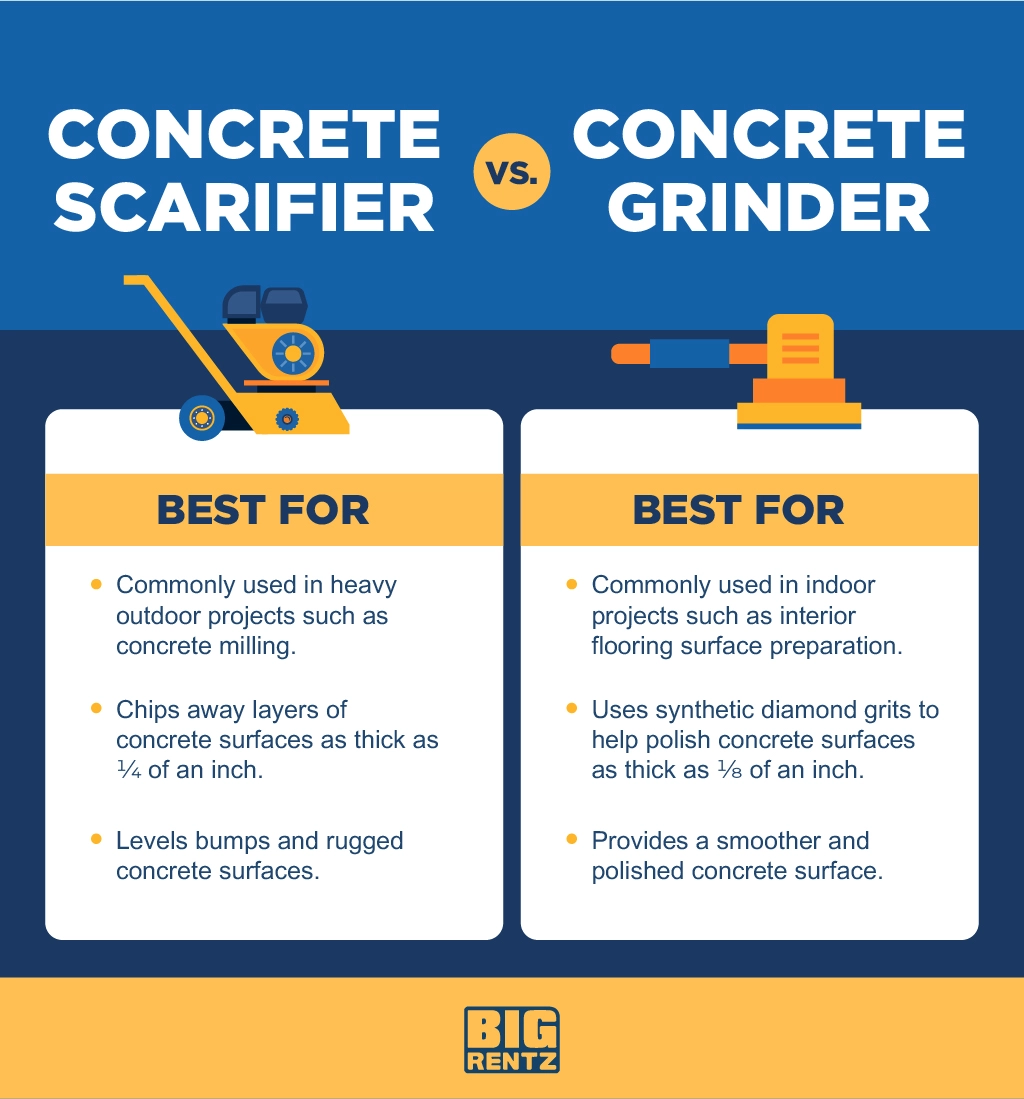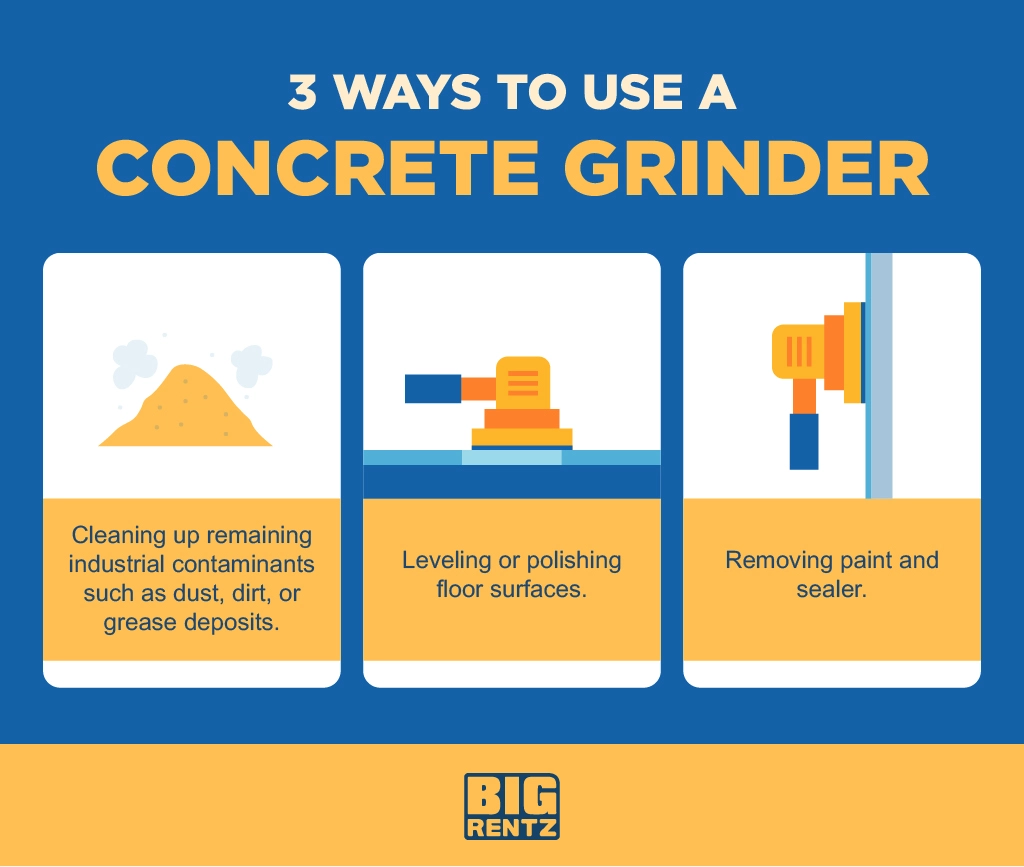Deciding between using a concrete scarifier and a concrete grinder will always come down to the project. While each tool achieves a similar result, the mechanics of the machines are different. Those differences make each tool great for certain projects but less than ideal for others.
To start, it is best to understand what a scarifier and grinder are. After that, their usage becomes much more clear.
What Is a Concrete Scarifier?
A concrete scarifier is a heavy-duty machine used to remove the top layer of concrete surfaces. It has cutting wheels that are equipped with blades and flails which violently chip away at concrete and epoxy surfaces.
Scarifiers are great options for high-output surface preparation. Through high-impact cutting, these machines are best for projects requiring the removal of up to 1/4″ of concrete at a time.
The concrete scarifier is also known as a surface planer, concrete planer, or milling machine. Concrete scarifiers are usually the tool of choice for removing layers of concrete surfaces.
These machines use spinning blades that are attached to a rotating drum to aggressively shave away concrete surfaces. Another potential benefit of a scarifier is the deep grooves left on the surface after a pass of the machine. These grooves are ideal for non-slip applications.
Concrete scarifiers can remove most surface coatings and features. They will also dig into the concrete layers below. Because of this, a concrete scarifier isn’t great for projects that need to maintain the integrity of the concrete surface.
What Is a Concrete Grinder?
A concrete grinder is best suited for the removal of coatings, surface materials, and textures. Unlike a scarifier, it does not dig as deeply into the concrete, nor does it leave deep grooves on the surface. Instead of a bladed, spinning drum, it uses diamond grinding pads.
A grinder is often used to level out and polish concrete surfaces when a floor is uneven, damaged, or the surface needs to be repaired. They are also ideal for removing thin coatings.
Concrete grinders typically come in handheld versions or floor-grinder versions. The handheld version can get into more hard-to-reach areas and perform more precise work. Meanwhile, the floor version can handle a wider range of materials such as marble, granite, or concrete.
Unlike scarifiers, grinders trade depth for precision. Grinders are typically used for indoor projects. And though they do contribute to non-slip properties, they are not ideal for outdoor uses. Thus, it is unusual to see these used on civil or industrial projects, including street work.
Concrete Scarifier vs. Concrete Grinder

Concrete scarifiers and concrete grinders are both designed to remove surfaces and layers from a concrete floor. But the distinct differences between them create specific areas in which they excel and others where they aren’t suited.
In general, concrete scarifiers will be the first choice for outdoor and high-traffic areas. Alternatively, concrete grinders will be more useful for indoor concrete projects. This includes flooring preparation and finishing.
Concrete Scarifier Uses
Concrete scarifiers are an ideal choice for aggressive projects. The speed and durability of the spinning blades and flails are made to batter surfaces, removing chips and shards in the process. Because of this, the worker is less able to control the finer details of the resulting surface. Therefore, it will be difficult or impossible to achieve a finished look when using a scarifier.
Most concrete scarifiers will feature adjustable cutting depths. This allows the machine to tackle many different projects. The ideal uses for concrete scarifiers include:
- Heavy-duty concrete tasks, such as grooving walkways or removing floor-tile mastics.
- Chipping away concrete at a higher speed.
- Removing concrete from a sidewalk or road.
- Grooving concrete walking and driving surfaces for slip prevention.
Scarifiers come in various sizes, including the width and diameters of the cutting area. They can also attach various styles of cutters. This allows greater effectiveness for specific projects. Choices include the number of cutting teeth, teeth material, and even the style of the teeth themselves.
This guide will also go in-depth into common practical scenarios where concrete scarifiers shine. But for any task needing aggressive concrete removal or planing, scarifiers are the first option.
Concrete Grinder Uses
Unlike scarifiers, concrete grinders are the first choice for the finishing stages of a project. Instead of spinning blades, concrete grinders use metal grinding discs coated with diamond particles. Much like sandpaper, these disks come in a variety of abrasives and grits that are better suited to specific projects.
Because of this variety, grinders can be used for a number of projects. These range from coating removal to final polishing. The grit choice will determine these uses. For example, larger diamond particles have a lower grit number.
Disks with lower grits are more often used for more heavy-duty projects, such as removing thick coatings.
Likewise, higher grit numbers are achieved with smaller diamond particles. Disks with higher grit ratings are better suited for delicate finishing applications.
Other projects that call for a concrete grinder instead of a scarifying machine include:
- Polishing up concrete surfaces for sealant application.
- Clearing up remaining industrial contaminants from the concrete scarifier.
- Leveling out minor bumps and overlays of any concrete floor.
- Removing glues, paints, and other coverings from an intact surface.
Grinders are also used to leave a concrete surface shiny and polished. These are used in warehouse settings for walkways. Plus, grinders can also be used to polish a floor into a stone-like look.
Below, this guide will explore three of the most common professional uses of a concrete grinder.
Concrete Scarifier Projects

Concrete scarifiers can be used in nearly every high-impact concrete removal application. However, there are four main types of projects that call for a concrete scarifier.
- Shaving off sidewalk grooves: Most sidewalks or walkways are made from concrete and are usually flat. Over time, the slabs of sidewalks shift and become uneven due to weather conditions, erosion, and frequent use. Scarifiers help cut and even out the concrete.
- Creating level surfaces: Sidewalks aren’t the only civil area to benefit from concrete scarifiers. Traffic lines, parking lots, and even heavy-tile floorings are no match for a scarifier. The heavy-milling operation of a scarifier will remove jagged or uneven surface features.
- Removing parking lot lines: Road markings must be efficiently removed without causing damage to the concrete surface, which makes scarifiers ideal for chipping away damaged markings or traffic lines, while also resurfacing the concrete.
- Removing damaged concrete: Because they can operate at a high speed and can have a cutting depth of up to ¼ inches, scarifiers can remove entire sections of damaged concrete surfaces. Scarifiers can return damaged concrete and asphalt surfaces to a clean and working level.
Concrete Grinder Projects

Concrete grinders are often used for more specialized roles. These tools feature better control and less aggressive surface treatment than scarifiers. Because of this, the ideal project for a concrete grinder is generally a finishing step. Projects that require the delicate removal of some surface material also call for grinders.
- Leveling or polishing floor surfaces: Grinders are ideal for resurfacing projects that want to maintain the integrity of the base floor below. They are also great for smoothing high spots and polishing a surface. Because of the different grits of grinding disks, surfaces can be finished for many uses. These range from decorative stonework to surface prep.
- Removing paint, sealer, or tile glue: A concrete grinder has a cutting depth of up to 1/8″. This makes them great tools for removing coatings such as thin paint, tile glue, and sealer.
- Cleaning up remaining industrial contaminants: Tungsten carbide cutters can be added to clean up and remove adhesives, tar, and rubber deposits. These inserts are hard and durable and are capable of grinding away stubborn contaminants. This grinding action also prevents any industrial contaminant buildup such as dirt, dust, or grease deposits.
Because grinders don’t cut into the surface, they can be used to smooth out irregularities left by less-precise machining. This includes scarifiers and other surface machinery.
Grinders will typically have built-in dust extractors. This helps to remove all powdered remnants during and after a job. This leaves very little dust in the air and helps to reduce and prevent any industrial contaminants from being introduced into the air. If your grinder doesn’t come with a dust extractor, they are easy to install yourself.
Conclusion
Concrete scarifiers and grinders are great tools for different jobs. Choosing which one is best depends entirely on the project they will be used for. Often, projects will use both tools for maximum effectiveness.
In general, heavy-duty tasks such as surface removal and groove cutting will call for a scarifier. These machines are often used for outdoor tasks where large portions of a surface must be removed or resurfaced for safety.
On the other hand, concrete grinders will most often be found indoors. They are typically used to finish and polish surfaces. Grinders are also great tools for removing layers without actually damaging the surface beneath.
Now you know how to choose the best tool for the job. Whenever you’re ready to begin your project with either a concrete grinder or scarifier, always remember to wear goggles and a mask while operating the equipment.